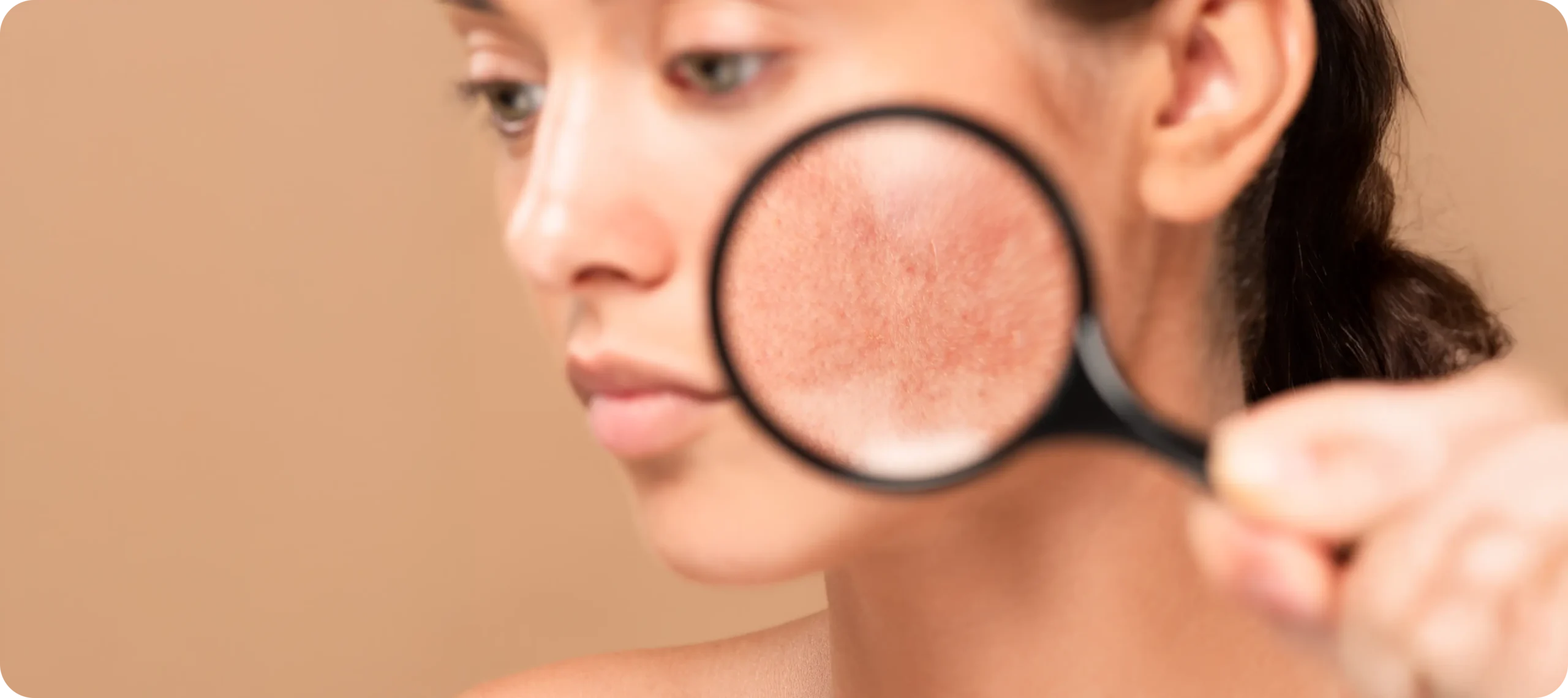If you’ve ever looked in the mirror and wondered whether those red patches and bumps on your face are rosacea or acne, you’re not alone. They can look surprisingly similar, but they’re two very different skin conditions. I know how frustrating it can be when you’re trying treatment after treatment without much improvement—especially if you’re actually treating the wrong issue. So let’s break it all down together, and I’ll walk you through how to tell them apart and what to do about each one.
What Rosacea Really Is
Rosacea is one of those conditions that tends to creep in quietly. You might start off just noticing that your face goes red more easily—maybe after a glass of wine or a spicy meal—but over time, that redness hangs around longer than it used to. It’s usually most noticeable in the middle part of your face: your cheeks, nose, chin, and sometimes your forehead. This isn’t the kind of flushing that fades quickly—it lingers, and over time, it can become a permanent fixture. If you’ve ever looked in the mirror and felt like you looked constantly sunburnt, that could be a big clue.
Another thing people don’t always realise is how sensitive rosacea-prone skin can be. You might apply a new product and instantly feel a stinging or burning sensation. Even the weather can affect it—wind, heat, cold, or humidity might all trigger a flare-up. On top of that, small red bumps can appear, which is why rosacea often gets mistaken for acne. But unlike acne, these bumps don’t come with blackheads or whiteheads. They’re more about inflammation than blocked pores, and the overall skin texture can feel rough or irritated.
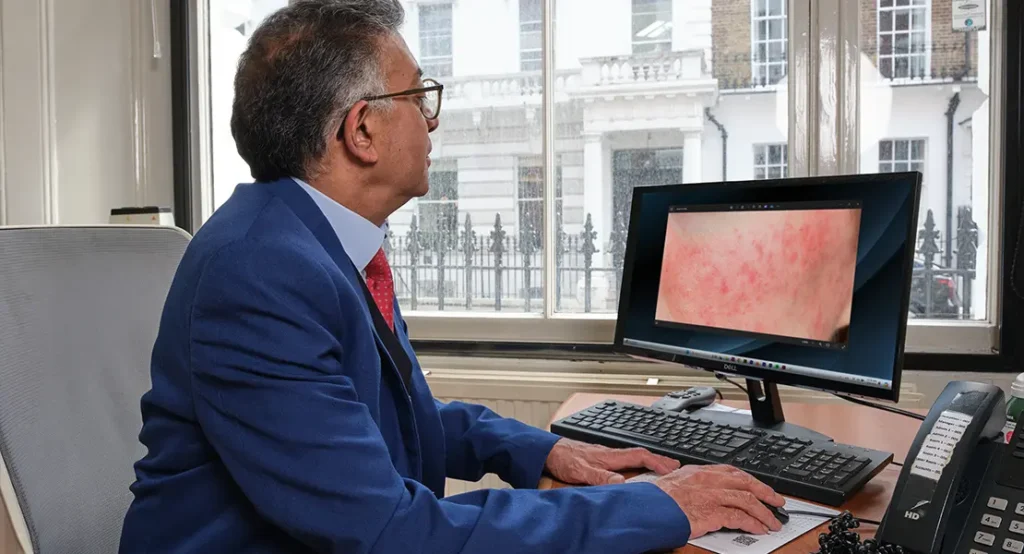
There’s also a version of rosacea that affects the eyes—something not everyone knows about. If your eyes feel dry, gritty, or like they’re burning for no clear reason, it could be ocular rosacea. It can cause redness along the eyelids, sensitivity to light, and a sensation that there’s something in your eye even when there isn’t. That’s why it’s so important to pay attention to what your skin and eyes are trying to tell you. Rosacea isn’t just about visible redness—it’s a deeper, more reactive skin condition that really needs the right care and attention to keep it in check.
And What About Acne?
Acne, on the other hand, usually kicks off in your teens, thanks to those ever-changing hormones. It’s linked to a mix of things—oil production going into overdrive, skin cells not shedding properly, pores getting blocked, and sometimes the presence of bacteria that inflame the skin. It’s a frustrating condition because even though it’s so common, it shows up in so many different ways. You might deal with the occasional spot or two, or you might be facing widespread breakouts that feel like they’re never going away.
One thing that sets acne apart is the variety of spots it creates. You’ve got blackheads, which are open clogged pores, and whiteheads, which are closed ones. Then there are the red, angry-looking bumps (papules), and the ones filled with pus (pustules). Some people even get deep, painful cysts under the skin that can last for weeks. These types of breakouts can appear not just on your face but also on your back, shoulders, and chest, which can really affect your confidence, especially if you’re dealing with visible marks or discomfort when wearing certain clothes.
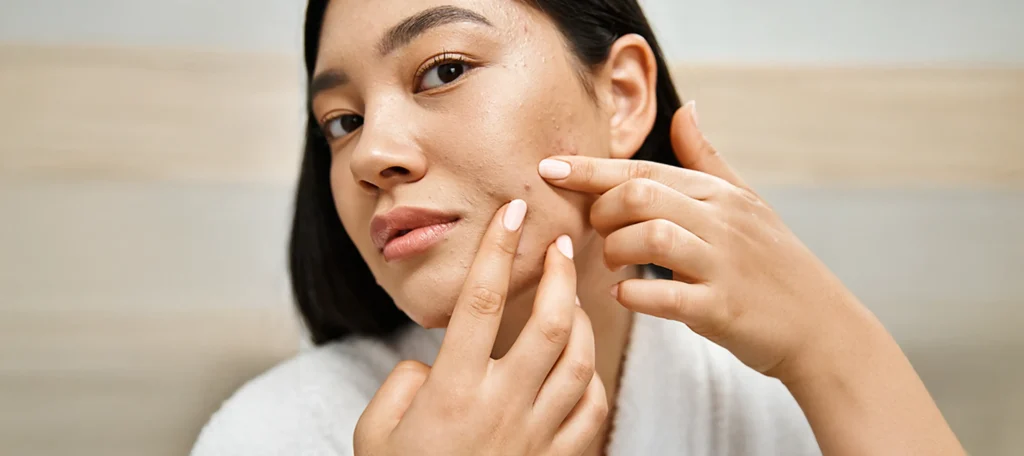
What’s particularly tough about acne is that it can leave a lasting mark—not just physically, with scars or pigmentation, but emotionally as well. A bad breakout can really knock your self-esteem. And because it can persist well into adulthood, many of us feel like we’ve missed that magic age where it was “supposed” to stop. The good news is that acne is highly treatable with the right approach. But it’s important not to confuse it with rosacea, because although they both cause bumps, the causes—and solutions—are very different. That’s why getting the right diagnosis from a dermatologist can make such a big difference.
So, How Can You Tell the Difference?
- Where is it?
Rosacea tends to stay loyal to the central areas of your face—think cheeks, nose, chin, and forehead. It doesn’t usually venture beyond these zones. If the redness or bumps you’re seeing are concentrated in this area and seem persistent, rosacea could be the likely suspect.
On the other hand, acne is much more adventurous. It often starts on the face but can easily travel down to your back, shoulders, and even chest. If you’re noticing spots popping up in these areas, particularly in a more spread-out pattern, you’re probably dealing with acne rather than rosacea. - What kind of spots are we talking about?
Acne brings a whole variety of blemishes to the table—blackheads, whiteheads, pustules, cysts—you name it. It’s not uncommon to see a mix of these types across your skin, often accompanied by oiliness and clogged pores. These features are key giveaways when trying to identify acne.
Rosacea, meanwhile, doesn’t involve blackheads or whiteheads at all. Instead, it usually shows up as persistent redness, visible blood vessels, and sometimes red, pus-filled bumps that might resemble acne—but without the classic comedones. That difference in the type of spots is a crucial clue when figuring out what’s going on. - How’s your skin behaving?
One of rosacea’s hallmark features is sensitivity. If your skin tends to flush easily, feels hot or stingy, or reacts badly to even gentle skincare products, that’s often a sign of rosacea. These symptoms are due to an impaired skin barrier and increased reactivity in blood vessels, which are common in rosacea-prone skin.
Acne-prone skin, while it can also be sensitive, generally doesn’t react in the same flushed or stinging way. Acne is more about oil production and blocked pores. If you’re dealing with breakouts but your skin otherwise feels stable and doesn’t overreact to basic skincare, acne is more likely than rosacea. - When did it start?
Age of onset can be a big clue. Rosacea typically makes its first appearance in adults over 30, although it can sometimes show up a bit earlier. It often starts subtly with some flushing or redness that gradually becomes more noticeable and persistent over time.
Acne usually kicks off during the teenage years, driven by hormonal changes. While it can persist into adulthood—or even start for the first time in adulthood—it’s more classically associated with younger skin. If you’ve battled spots since your school years, chances are acne is the underlying cause.
Still not sure?
Honestly, the best thing you can do is see a dermatologist. Skin conditions can overlap or present in confusing ways, and trying to self-diagnose can lead to using the wrong treatments, which may make things worse. A professional can quickly identify the issue and steer you in the right direction.
Getting a clear diagnosis is the foundation for effective treatment. Whether it’s rosacea, acne, or a combination of both, your skin will benefit from a tailored approach. A dermatologist will not only confirm what’s going on but also help you understand your triggers and guide you to a skincare routine that actually works.
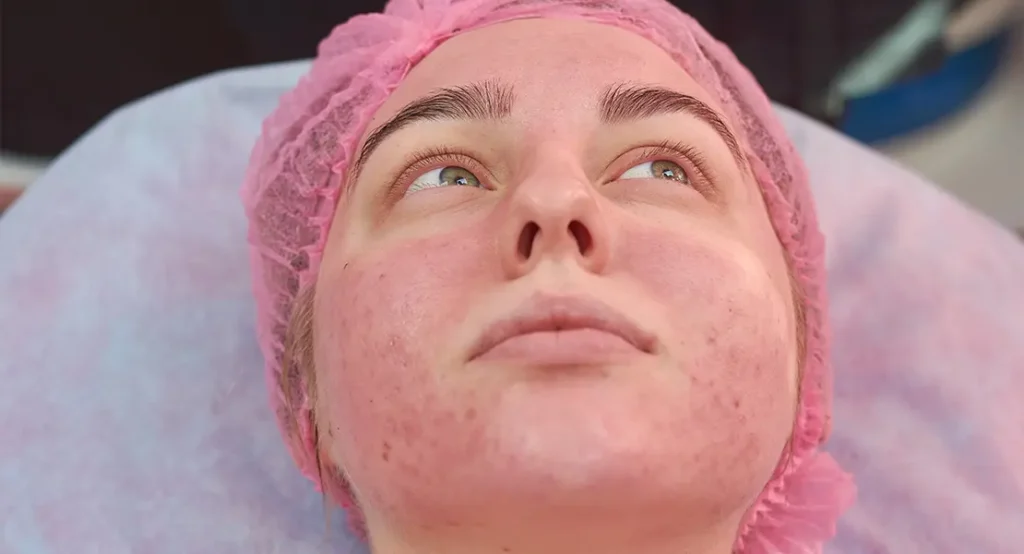
Rosacea Treatment
Treating rosacea is all about calming the skin and keeping it as stable as possible. This means focusing on gentle skincare routines that support your skin barrier, reduce inflammation, and avoid any harsh ingredients that could trigger a reaction. Choosing products designed for sensitive or reactive skin can make a noticeable difference, especially those free from fragrance, alcohol, or exfoliating acids. The goal is to create an environment where your skin feels soothed rather than stressed.
Equally important is identifying and avoiding your personal rosacea triggers. These can vary from person to person, but common culprits include spicy foods, alcohol, hot drinks, sun exposure, and extreme temperatures. Emotional stress can also play a role, as can overuse of certain skincare products. Paying attention to what causes your flare-ups and making small adjustments in your daily routine can help you take control of your symptoms and prevent things from getting worse.
While there’s no permanent cure for rosacea, the good news is that it can be managed really effectively with the right approach. Many people see a dramatic improvement once they find what works for them—whether that’s topical treatments, prescription medication, or simply a well-planned skincare routine. The key is consistency and patience. With the right care, flare-ups can become far less frequent, and your skin can feel much calmer and healthier overall.
Here’s what usually works:
- Topical treatments:
- Metronidazole cream or gel – helps reduce inflammation
- Azelaic acid – calms redness and clears up bumps
- Ivermectin – targets microscopic skin mites linked to rosacea
- Oral antibiotics:
- Low-dose doxycycline – helps control inflammation and breakouts
- Laser or light therapy:
- Targets visible blood vessels and persistent redness
- Daily skincare habits:
- Use gentle, fragrance-free cleansers and moisturisers
- Always wear SPF (rosacea-prone skin is extra sensitive to sun)
- Avoid harsh scrubs, alcohol-based products, and anything that stings
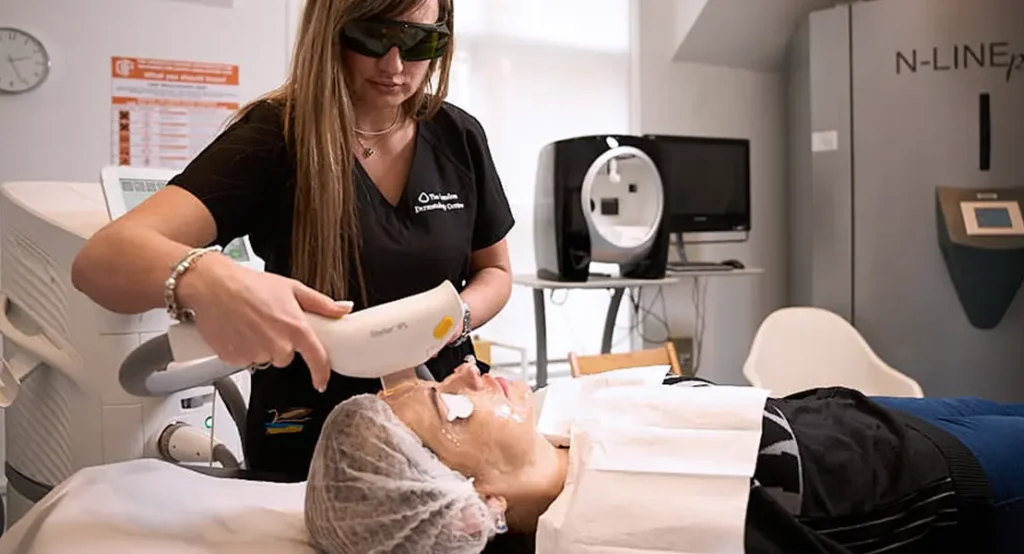
And just as important—figure out your personal triggers. Common ones include:
- Spicy foods
- Hot drinks
- Alcohol (especially red wine)
- Heat, cold, or wind exposure
- Emotional stress
Once you know your triggers, it becomes so much easier to manage flare-ups.
Acne Treatment
Treating acne starts with targeting the root causes: clogged pores, excess oil, and inflammation. The skin naturally produces oil to stay hydrated, but when this process goes into overdrive, it can lead to blockages that trap dead skin cells and bacteria. This buildup often results in breakouts that can range from small blackheads to painful cysts. Effective treatment aims to keep pores clear and reduce the overproduction of oil without stripping the skin or causing further irritation.
Since not all acne is the same, the approach should vary depending on the type and severity. For mild to moderate acne, over-the-counter products with ingredients like salicylic acid or benzoyl peroxide can help keep breakouts in check. These work by exfoliating the skin and killing acne-causing bacteria. For more persistent or inflamed types, such as hormonal or cystic acne, prescription options might be necessary. These could include topical retinoids, antibiotics, or even oral medications like hormonal treatments, depending on what’s triggering the acne in the first place.
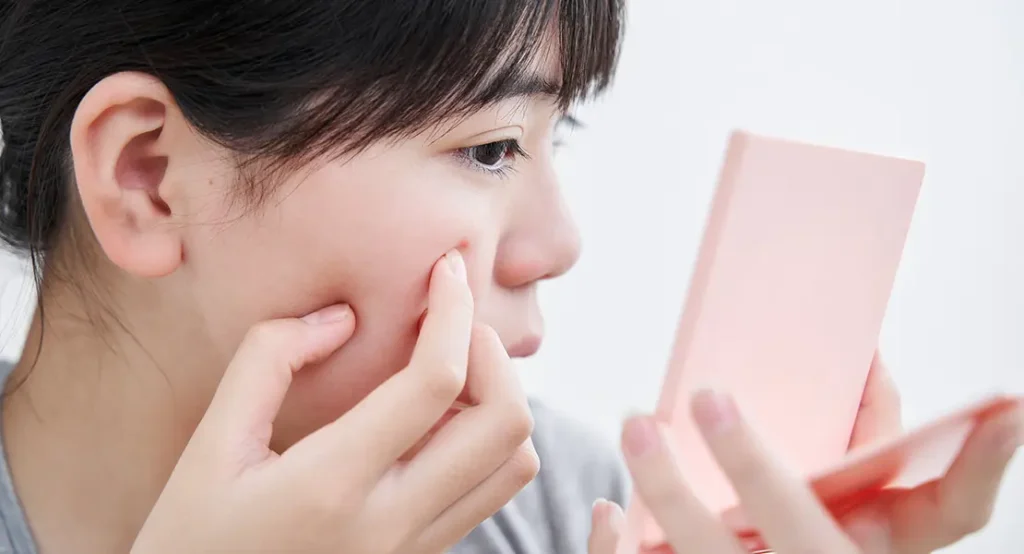
Finding the right routine is often a process of trial and error. What works wonders for one person might do very little for another. That’s why it’s important to listen to your skin and introduce new treatments gradually. Alongside targeted products, lifestyle changes—like managing stress, eating a balanced diet, and avoiding pore-clogging makeup—can also support your skin’s recovery. Ultimately, treating acne isn’t just about clearing it up quickly but also about building a long-term routine that helps prevent future breakouts while keeping your skin healthy and resilient.
- Topical treatments:
- Retinoids – unclog pores and speed up skin cell turnover
- Benzoyl peroxide – kills acne-causing bacteria
- Salicylic acid – breaks down dead skin and reduces blockages
- Oral medications:
- Antibiotics – like lymecycline or doxycycline to reduce bacteria and inflammation
- Hormonal treatments – such as the contraceptive pill for hormonally-driven acne
- Isotretinoin (Roaccutane) – for severe, cystic acne that doesn’t respond to other treatments
- Simple skincare tips:
- Cleanse gently twice a day—don’t over-wash
- Don’t pick! It only makes things worse
- Keep makeup non-comedogenic (aka, non-pore-blocking)
Seeing a dermatologist really helps here too, especially if you’ve tried shop-bought products without much luck. They can tailor a treatment plan based on your specific type of acne, skin sensitivity, and lifestyle.
Summary
At first glance, rosacea and acne might seem like different versions of the same problem—but they’re not. Rosacea is more about redness, sensitivity, and flushing, while acne is driven by blocked pores and oil. One can’t be treated like the other, which is why knowing the difference matters so much.
If you’re still unsure what’s going on with your skin, don’t guess—see a dermatologist. The right diagnosis changes everything. With a bit of the right advice and a personalised routine, clearer, calmer skin is completely within reach.
If you’re concerned about acne or rosacea, you’re welcome to contact us at the London Dermatology Centre to consult with one of our expert dermatologists. We’re here to help you understand your skin and find the treatment that works best for you.
